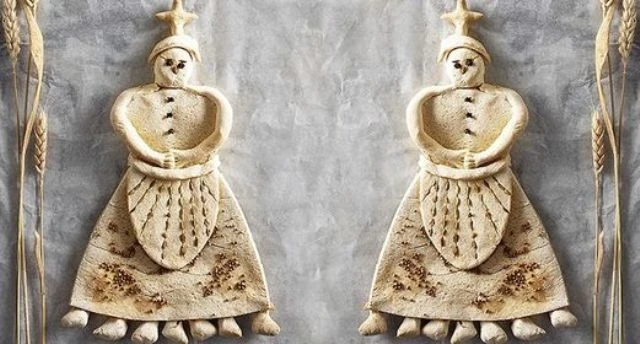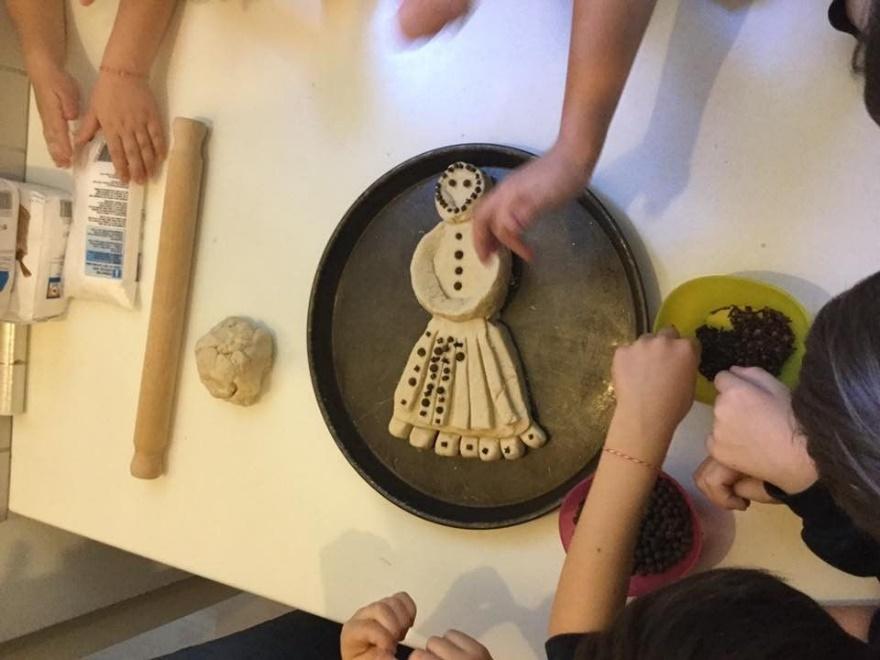
A Cultural journey of Places, Customs, Traditions and Roots
The manners, customs and traditions of the Greek people come mainly from antiquity and Byzantium and are often associated with the Christian religion. They have also been influenced by the various conquerors and by neighboring peoples.
These customs can be divided into categories. The first classification is related to the so-called cycle of human life, that is, to the three most important stations of human life: birth, marriage, and death. The second category consists of the manners and customs associated with the so-called cycle of the year, that is, with the occupations of people and with religious celebrations in the four seasons of the year.
Customs with history, lost in the depths of the centuries. Cultural practices, preserved since the time of Homer. Traditions tied to the different “tribes” and cultures of the place. Habits inextricably linked to places, communities, but also to celebrations. The melodic lullaby of the mother, the legends of the grandfather, the carols, the swallows, the mantinades, the customs, the dances and the tunes that accompanied us in every joy, the costumes, the embroidery, the couplets, the games, and everything else that is part of the life of our Country. When customs are steadily repeated from generation to generation, traditions are created.
From Crete to Macedonia and from the Aegean to the Ionian Sea. Greece offers such a richness, diversity and “polychromy” of customs and traditions. Together, let’s discover the roots of these customs and traditions-the ones that give Greece its special character. Keep these treasures intact and alive in your hearts and pass it on to future generations! This way, we ensure that our cultural heritage will continue to beat and persevere for centuries to come.
Kalanda
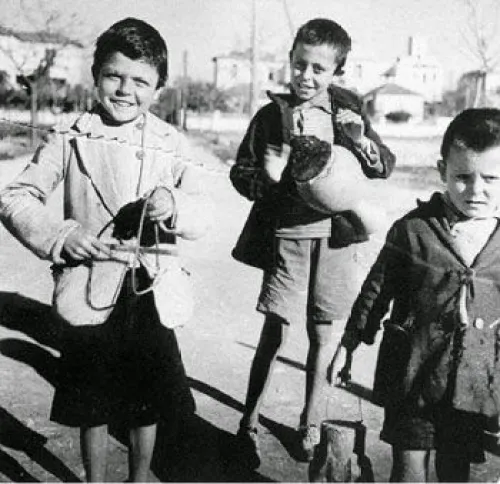
The Carols are of Byzantine origins and were celebrated with great splendor. Carols are wishful folksongs that are sung customarily every year mainly on the eve of major religious holidays such as Christmas, New Year’s Day (St. Basil), Epiphany, even Palm Sunday and Saturday of Lazarus. In some areas of Greece, the day that the carols are sung is specifically called Kolinda, Kolentas, Koliantas.
Carols are sung mainly by children but also by adults, either individually or in groups. Groups or individuals go to homes, shops, public places, etc. accompanied by the traditional iron triangle (Trigona), as well as other musical instruments like the tsambouna, lute, harmonica, and accordion. Children usually ask, “Shall we tell them?” and wait for the answer “Tell them.” Before they start singing the carols.
The main purpose of these songs is to convey one’s wishes for the holiday and to collect a gift from the recipient. Today, the gift is usually money but in the old days it was products that the children would donate to the church. The housewives, depending on the region, gave the children fruits, nuts (walnuts, hazelnuts) , raisins, eggs, butter, kavourma (καβουρμα) and «πλιγουρι». Also, those who wished gave a monetary donation along with the products.
On the coast of Asia Minor, the children sang carols, holding jugs (tramboukes-pilina toumbana) and vaporakia (boats) in their hands. They built and decorated colorful ships with bright lanterns and paper tassels. Sometimes, instead of ships, they built paper churches that were illuminated internally and resembled Hagia Sophia.



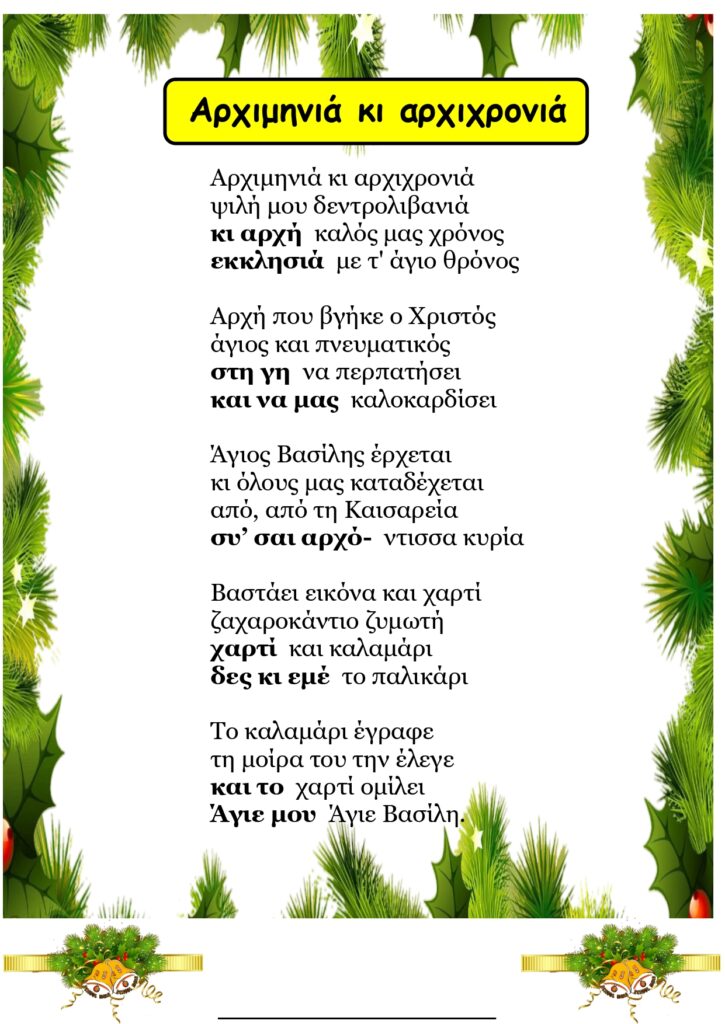
LAZARIAN CAROLS
Κάλαντα του Λαζάρου – Πού ‘σαι Λάζαρε.
The most widespread custom for the Saturday of Lazarus is the singing of the “carols of Lazarus”. The Lazarian carols were almost exclusively a women’s affair with the little “Lazarines” singing and announcing the joyful feast.
On the eve of the feast, the Lazarines (girls) went out into the fields and gathered flowers with which they decorated small baskets. Wearing traditional folk costumes, they went from house to house singing the carols and in exchange received a small tip, money, eggs, fruit, or other edibles.
The custom of the Lazarian carols, especially during the Turkish occupation, had a social purpose. This allowed the girls to go outside the house and into the neighborhoods where they could meet potential mates.
LYRICS:
«Που ‘σαι Λάζαρε που είναι η φωνή σου,
που σε γύρευε η μάνα κι αδερφή σου.
Ήμουνα στη γη στη γη βαθιά χωμένος,
κι από τους εχθρούς εχθρούς βαλαντωμένος.
Βάγια βάγια των Βαγιών τρώνε ψάρια των κολιών,
και τηνλλη Κυριακή τρώνε το παχύ αρνί»
Puse Lazare, Pu ine I foni su
Pu se grieve h mana su ki aderfi su
Imouna sti gei vathia homenos
Ki apo tus ehthrus balandomenos
Vayia Vayia ton Vayion trone psari ton kolion
Kai tin alli Kyriaki trone to
Pahi arni
Christmas Traditions
CHRISTOPSOMO


Christopsomo: The decorated bread of Christmas
Christopsomo is the bread (loaf or kouloura) that Greek women make in honor of Christ with special care and patience. This bread is usually made 2-3 days prior to Christmas. It is the blessed bread of the Christmas table. On Christmas Day, the housewife would take the bread, make the sign of the cross, cut it and distribute it to all the family and to those present at the Christmas table. (Some here see a symbolism of Holy Communion; just as Christ gave the bread of life to all his human family…).
The Christopsomo shape varies, sometimes it is a loaf, sometimes an open or closed bagel and other times it is baked in a baking pan. But one thing it always has is ornaments and symbols.
The form, shape and decoration of this bread are determined by local customs. The only difference with the other usual breads is its rich decoration with various embroideries (embroideries) or “plumes” as they are called. In most places, in the center of the bread, they form a cross with dough and at its edges they place almonds and walnuts, which are symbols of rich production. If nowadays they have been limited to the cross and crescent moons, in the past they were proportional to the special activities of each family and the customs of the region. Agricultural tools, straws, sheep, shepherds appeared as appropriate as plumes of dough on the bread.
One of the most impressive Christopsoma of this kind is Sarakatsanika. The Sarakatsani believe that Christmas is the pastoral holiday par excellence because Christ was born among shepherds and sheep. So their Christopsoma bear whole performances with pastoral scenes.
Christopsomo is also offered as a gift. Even today the guests may bring the hostess a Christopsomo for the Christmas meal. In the past, engaged girls used to send such bread to their fiancées. Such an important bread does not exclude the poor and those in need. To this day, one of the first pieces is saved for when the first beggar or stranger comes knocking on the door. The dead are not excluded either. On Christmas Day, christbread was distributed to the poor for the souls of the dead.
Christopsomo Recipe
Ingredients
· 280 ml of water at room temperature
· 7 grams of dry yeast
· 60 grams granulated sugar
· 50 ml olive oil
· 1/2 kg of flour
· 1 teaspoon cinnamon
· 1/2 teaspoon of ground cloves
· 1/2 teaspoon salt
· 100 grams walnuts (chopped)
· 100 grams raisins
· 1 egg (beaten)
· For decoration
· A few cloves
· 1 walnut, in it’s shell
· Some shelled walnuts
· Some of the dough to form the decorations
· Sesame seeds
· Some almonds
Instructions
1. Mix the yeast with the warm water and the half of the sugar, stir until dissolved and set it aside until it bubbles.
2. In a large mixing bowl, combine the salt, cinnamon and ground cloves with the flour. Make a well in the centre of the flour and pour in the yeast mixture and the olive oil. Mix until a soft dough forms, cover with waxed paper and a damp towel, and set aside to rise for 15 minutes.
3. Punch the dough down and knead for several minutes. Add the raisins and the walnuts and knead well to a homogenous dough!
4. Cover, and allow it to rise for 1/2 hour. Take a part of the dough and set it aside.
5. Create a nice, soft ball from the dough, with your hands, and shape the bread as I have in the pictures. Cover a baking pan with ovenproof paper, put the dough on it, cover it with a damp cloth and let it rest while you are creating the decorations.
6. Roll the saved dough into strips and create the cross. Brush the top of your bread with a beaten egg and set the cross on the top. Decorate it with walnuts and cloves or anything you like. Brush again with the rest of the egg.
7. Bake in a hot oven at 200 °C for 25 to 30 minutes, reduce the heat to 170 °C and bake it for another 10 minutes.
Servings : 8 people
https://katerinaskouzina.com/recipe-items/christopsomo-greek-christmas-bread/
https://katerinaskouzina.com/recipe-items/christopsomo-greek-christmas-bread/



New Year's Traditions
Η Βασιλόπιτα - Vasilopita
According to tradition, vasilopita was the creation of Basil the Great of Caesarea, who created this trick to distribute money to the poor. He hid the coins in pies and offered them to the poor. To honor this tradition today, we also place a coin in the vasilopita in the hopes that whoever finds it will be lucky for the year.
Vasilopita can be made in a variety of ways, depending on the region, with almost every family having their own unique recipe. There are two main variations of Vasilopita – the cake or the tsoureki version. This is a sweet cake with a bread-like texture that is made especially for New Year’s. The sweetness of the bread symbolizes the hope that the New Year will be filled with the sweetness of life, liberty, health and happiness for all that participate in cutting of the Vasilopita
Recipe for cake:

https://akispetretzikis.com/en/recipe/568/vasilopita-keik
1st mixture:
300 g butter, at room temperature
250 g icing sugar
½ teaspoon ground nutmeg
2 g mastic
7 g mahlab
1 tablespoon granulated sugar
2 tablespoons all-purpose flour
grated zest of 1-2 oranges
2 packets vanilla powder or 2 teaspoons vanilla extract
2nd mixture:
4 eggs (200 g)
75 ml milk 3.5% fat
3rd mixture:
400 g all-purpose flour
1 tablespoon baking powder
Instructions:
Preheat oven to 180* C (350*F) Fan.
Beat the butter and icing sugar in a mixer, with the paddle attachment until light and fluffy. Stop beating and scrape down the sides of the bowl. Beat for another 5 minutes. (It is important that the butter is at room temperature. The softer it is the fluffier your mixture will be.)
While you are waiting, add the remaining ingredients from the 1st mixture (apart from the orange zest) and beat them in a blender along with a tablespoon of sugar, until they become powdery. When ready, add the orange zest and mix.
Add this powdery mixture to the mixer and beat on low speed.
Add all the ingredients from the 2nd mixture, in batches. Release the mixing bowl and add the ingredients from the 3rd mixture. Mix with a large spoon.
Grease a round 25 cm springform baking pan and dust with flour. Transfer the batter to the baking pan.
Bake for 45-50 minutes.
When ready, remove from the oven and dust with icing sugar and serve!
If you would like to follow the Greek tradition, wrap a coin and place it somewhere on the cake before you bake it! It will be a Lucky New Year for whichever family member or friend finds it in their slice!!
RECIPE FOR TSOUREKI STYLE FROM CONSTANTINOPLE

Vasilopita tsoureki – Ingredients
1 kg of hard flour
18 g of yeast
1 teaspoon of mahlab
1 teaspoon of mastic
500 ml milk, 3,5%
125 g butter, at room temperature
240 g granulated sugar
3 eggs
1 teaspoon of salt
Οrange zest, of 2 oranges
1 egg yolk, beaten in cold water,
Almonds
A clean coin, wrapped in aluminum foil
Vasilopita tsoureki -Instructions
Start this vasilopita tsoureki recipe by taking a pot. Add the milk and the butter and bring to a boil over medium temperature until the butter is half melted.
Remove the pot from heat and once the butter is melted, add the sugar, eggs, salt, and orange zest, and mix.
Allow the mixture to become lukewarm.
Preheat the oven to 200°C and turn it down.
Take a mixer and add the flour, yeast, mahlab, and mastic and mix a bit. Gradually add the mixture from the pot, mixing the ingredients at medium speed.
When the dough becomes soft and does not stick, stop mixing.
Place the dough in a deep bowl. Cover it with a kitchen towel. Place it in the oven for about 40 minutes. The dough should double in size.
Grease a baking pan with butter.
Remove the dough from the oven, place the coin in the pan and evenly place the dough.
Decorate the vasilopita with the almonds
Place the vasilopita in the oven for about 15 minutes.
Gently spread the egg yolk on the surface of the cake with the help of a brush.
Increase oven temperature to 180°C and bake for around 30-40 minutes until it gets a nice golden color.
Remove from the oven and allow to cool down to room temperature.
PRAYER BEFORE CUTTING THE VASILOPITA
Let us pray unto the Lord. Lord, have mercy. O Creator of all things, Lord and King of the ages, plenteous in mercy and bountiful in goodness, who didst accept the Magi’s gifts in Bethlehem, who art the Bread of life that came down from heaven, who by Thine authority didst establish the seasons and the years and dost hold our life in Thy hands. Hear us who pray to Thee on this holy day upon our entrance into the new year of Thy goodness and bless (+) this Vasilopita, which has been offered to Thy glory and in honour of our Father among the Saints Basil the Great, Archbishop of Caesarea in Cappadocia. Do Thou who art Benevolent, look down from Thy holy heaven and send down upon us, upon those who have offered these gifts and upon them that partake thereof, Thine heavenly gifts, for our hope is in Thee, the living God, unto the ages. Bless this parish (home, school, foundation, etc) and our entrances and exits; replenish our life with all good things and direct our footsteps that we may keep Thy divine commandments, for man shall not live by bread alone; Through the intercessions of Thy Most pure Mother, of our Father among the saints Basil the Great and of all Thy saints who from all ages have been well pleasing to Thee. Amen.
Cutting the Vasilopita
The cutting of the Vasilopita and the method that is cut is also part of the tradition that has been passed down. Greek families cut the vasilopita at some point during New Year’s Day. In fact, many do so after the clock strikes midnight.
The person who cuts it is usually the head of the household or a senior member of the family. After the prayer is said, the person lifts the Vasilopita, kisses it, and makes the sign of the cross over it with his knife and proceeds to cut it.
The slices/portions are symbolically cut and served in a certain order: The first piece traditionally is cut for Christ, teaching us that we offer to the Lord, the first fruits of His blessings upon us. The second piece is cut for the mother of God, the Virgin Mary, and the third for St. Basil. The next piece is cut for the entire household hosting the event. This is followed by every family member and guest receiving a slice, with the recipients lining up from oldest to youngest.
Each person feels special and appreciated, having individually been remembered, receiving a portion of the blessed bread. Finally, a piece is always cut for the poor, reminding us to always keep a portion of our blessings for those who are in need.
Hidden within one of the pieces of the Vasilopita is a coin or a small piece of jewelry. The person who receives the piece with the coin receives a special blessing. There is a strong connection between the piece of Vasilopita which is cut for St. Basil and the one that is cut for the poor. It is believed that the person who finds the coin in his piece of Vasilopita will not only come into God’s good fortune for that year, but that he will also be able to care for the poor, widows, and orphans.
The cake is not only served in Greek households, but also in organizations and at businesses. Vasilopita events are also a popular fundraiser, where people pay for a piece of cake to benefit a charity.


LENT TRADITIONS
KIRA SARAKOSTI

TRADITION:
It’s a custom associated with the fasting period of Great Lent preceding the Sunday of Pascha.
She is drawn in the image of a nun. She has seven legs representing the seven weeks of Lent. Each of her legs represents one week of fasting starting from Pure Monday until Holy Week.
Her arms are folded because she’s constantly praying.
She has a cross on her head that represents her faith.
She has no mouth. This is not only because she cannot eat but also to avoid talking.
She has no ears, or her ears are covered with a scarf, so she does not listen to any gossip or idle speech.
The tradition has it that each week starting on Saturday after Pure/Clean Monday, one leg would be cut off. The last leg would be cut off on Holy Saturday. In some areas of Greece, the seventh leg was placed inside the Resurrection bread and was considered to bring blessings to whoever found it. Instead of cutting the legs, people also tied ribbons on the legs.
In some regions of Greece, Lady Lent is made of clay and or fabric filled with feathers. There are many versions of Lady Lent, in some traditions, she is depicted as a nun, in others, she is a friendly lady in traditional Greek folklore.
Recipe for Greek Lady Lent (Kira-Sarakosti)
Ingredients Kyra Sarakoti
2-2 1/2 cups flour
1/2 cup salt
2-2 1/2 tsp. cinnamon
water (as much as needed)
decorations as you wish
Items for decoration-white beans, lentils, cloves
* Not to be eaten! *
Combine the ingredients in a medium-sized bowl and gradually add the water to form a dough. Roll out the dough and after, cut the figure out as shown above. Cut out two long narrow strips for arms and join at shoulders (wet surface to which arms will be applied). Make slits in the dough for fingers. Mark closed eyelids and noise with any pointed object. Wipe the entire figure down with a lightly dampened cloth to make it shiny. Finally, bake the figure in a moderate oven until golden.
Pattern for Kira Sarakosti

Pascha
RED EGGS
SYMBOLISM AND SACRED ORIGINS
Easter eggs are dyed red to symbolizes the blood and sacrifice of Christ on the cross. Red is the color of joy. Joy for the Resurrection of Christ.The hard shell of the egg symbolizes the sealed Tomb of Christ—the cracking represents his resurrection from the dead.
While the origin of Easter eggs can be explained in the symbolic terms as described above, there are some sacred traditions about the red eggs. Followers of Eastern Christianity say that Mary Magdalene was bringing cooked eggs to share with the other women at the tomb of Jesus, and the eggs in her basket miraculously turned brilliant red when she saw the risen Christ.
A different, but not necessarily conflicting legend concerns Mary Magdalene’s efforts to spread the Gospel. According to this tradition, after the Ascension of Jesus, Mary went to the Emperor of Rome and greeted him with “Christ has risen,” whereupon the emperor pointed to an egg on his table and stated, “Christ has no more risen than that egg is red.” After making this statement it is said the egg immediately turned blood red.
Another tradition claims that after Christ was crucified and they put his body in the grave, one of the Mirofores wanted to bring flowers and myrrh (perfumes) to the grave but she did not have any money. She lived in a village-χοριο and only had eggs. She decided to take the eggs to a larger village nearby to sell them so that she can get money to buy the perfumes. As she was walking, she met up with the Apostle Peter who told her that Crist had risen. She did not believe him. Talking to herself on the way to the village after meeting the Apostle, she said that if the eggs in my basket turn red than and only then will I believe. When she arrived at the village agora-market, she opened her basket and all the eggs were red.
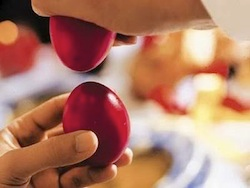
TRADITIONS
On the first hours of Easter Sunday and right after “Christ has risen” we crack red eggs during dinner. This tradition-while fun as a game-has the symbolism of resurrection and new life. The egg is seen by followers of Christianity as a symbol of resurrection: while being dormant it contains a new life sealed within it.
The game of tsougrisma (τσουγκρισμα) involves two players and red eggs. Each player holds a red egg, and one taps the end of her/his egg lightly against the end of the other player’s egg. The goal is to crack the opponent’s egg. When one end is cracked, the winner uses the same end of her/his egg to try to crack the other end of the opponent’s egg. The player who successfully cracks the eggs of the other players is declared the winner and, it is said, will have good luck during the year.
The egg dying and decoration took place on Holy Thursday, this is also why the day is called “Red Thurday” «Πέφτη ή Κοκκινοπέφτη». The pot used to dye the eggs had to be new, the eggs were always a certain number and the dye was saved and not disposed of for forty days. The dye was never disposed of outside the house. Apart from chemical dyes, there are some natural alternatives that were used. The onions made the honey colored egg, straw or almond leaves made yellow, the light red from poppies. In Corfu and especially in some villages, it is customary to dye eggs with beetroot. The eggs are boiled in water that have previously boiled for some time beetroot and have left their deep red color. Even though people could dye eggs other colors, the red was still the favorite because of its symbolism.
The first egg that was dyed belonged to the Virgin Mary and would be placed in the iconostasis and is saved in the home for protection against the evil eye until the next year when a new “first egg” is dyed. In some places of Greece, the housewife would take a basket of eggs (one for each family member) to church on Thursday night at the reading of the 12 Gospels and place it under the Altar until the Resurrection Service. The Blessed eggs would be picked up after the Resurrection Service and their shells were placed in gardens and near roots of trees so that they would have good crop.
In addition, women decorated the eggs using various means. Using waxed candles, they would write on the eggs and create patterns depicting the life of Christ, partridges, leaves etc. After making these patterns with the melted wax, the eggs would be dyed leaving the waxed area white where one could see the design. In Macedonia, the eggs were known as “ξομπλωτά” ή “κεντημένα” and they had beautiful images of birds especially the partridge. The fancy decorated eggs were often sent as a gift to a fiancée or godchildren send them to their godparents-to all the people they loved.
References:
http://ellinwnparadosi.blogspot.com/2011/04/
https://usa.greekreporter.com/2012/04/13/the-symbolism-of-cracking-red-eggs-on-easter/

TSOUREKIA/ΤΣΟΥΡΕΚΙΑ

Tradition has it that the tsoureki symbolizes the Resurrection of Christ and rebirth in general as the flour is molded into shape and rises and takes on life as it transforms into its final shape. The red-dyed egg which is usually placed on top of the braid symbolizes the blood of Jesus.
The symbolism of the Bread It has a three-strand braid to represent the Holy Trinity, the Father, the Son, and the Holy Spirit. The hard-boiled eggs get dyed red to symbolize the Blood of Christ. The egg is also a symbol of renewal and rebirth. An egg wash gives it a shiny coating that symbolizes the Light of Christ.
The symbolism of the Bread It has a three-strand braid to represent the Holy Trinity, the Father, the Son, and the Holy Spirit. The hard-boiled eggs get dyed red to symbolize the Blood of Christ. The egg is also a symbol of renewal and rebirth. An egg wash gives it a shiny coating that symbolizes the Light of Christ. The symbolism of the Bread
The bread itself is laden with symbolism. It has a three-strand braid to represent the Holy Trinity, the Father, the Son, and the Holy Spirit.
The hard-boiled eggs get dyed red to symbolize the Blood of Christ. The egg is also a symbol of renewal and rebirth.
An egg wash gives it a shiny coating that symbolizes the Light of Christ.
Recipe for Tsoureki:
https://savorthebest.com/greek-easter-bread-tsourek


